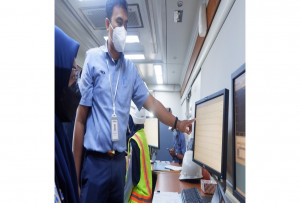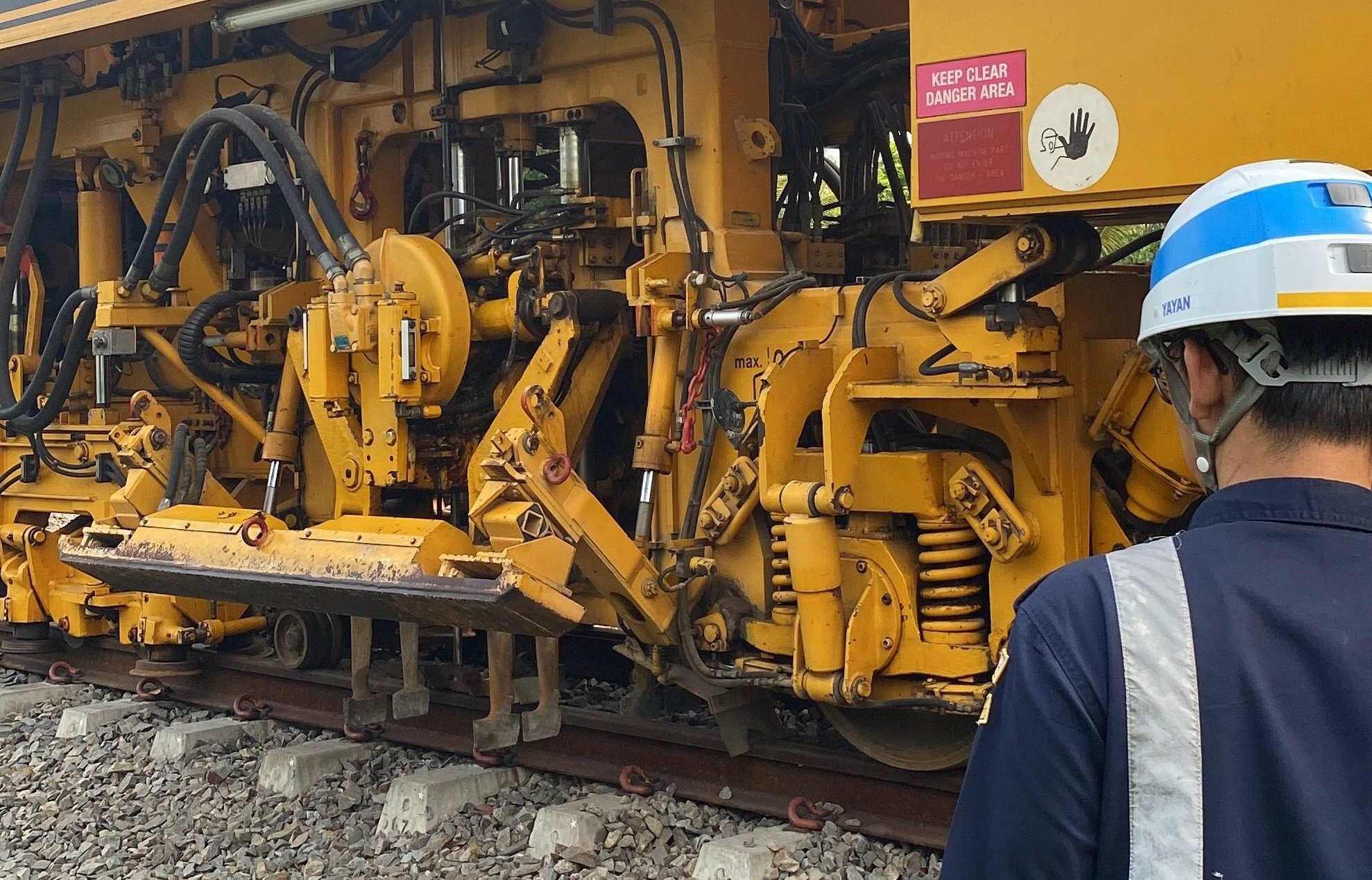Study on Operation of Ciremai Kereta Train Gauge

Grobogan – Dozens of technical teams conducted a study of measuring equipment for railroad geometry. The technical team comes from several lines of work within the Directorate General of Railways at the Ministry of Transportation. Consisting of the Railway Maintenance Center team, the Railway Testing Center team, and a team from the Directorate General of Railways Facilities Directorate.
The Head of the Railway Maintenance Center (Baperka) M Andi Hary Murty directly opened the study agenda for sharing knowledge on the operation of measuring instruments on measuring trains, accompanied by the Head of the Udut Periodic Maintenance Section, Pangihutan Sinaga. In addition, there were also speakers from PT INKA (Persero) and PT Inka Multi Solusi Service.
Andi said the knowledge sharing agenda was an effort to improve the performance quality of the technical team of the Directorate General of Railways in general and an understanding of the railway facilities of the Railway Maintenance Center in particular.
“Knowledge of the concept of supporting equipment for the maintenance of railway infrastructure, in this case the Measure Train, is an important requirement in order to support the tasks of the Directorate General of Railways. Knowing the concept of measurement on measuring instruments will provide basic considerations in carrying out operations, monitoring, and maintenance tasks correctly from clear standards, "said Andi.
The study on railway facilities initiated by the Railway Maintenance Center was held in the Ngrombo workshop area for three days starting on Monday (4/4/2022). Taking place in the Ngrombo Workshop Hall and Building, Grobogan Railway Maintenance Center, for material study sessions and static learning. As well as taking the route from Ngrombo Station to Brumbung Station round-trip, for field simulations or dynamic learning.
Based on the monitoring of the implementation, the activities on the first day included presentation material activities that were brought by PT INKA (Persero). The material is more about the presentation of the components in the measuring cart. In addition, it contains the concept of using measuring instrument components and how the flow of the measurement mechanism can be carried out.
On the second day, the participants were in the Ngrombo Workshop building, the Railway Maintenance Center. There, participants saw firsthand the stable measuring carriage in the Ngrombo Workshop area. The measuring carriage that is the object of the study is the Ciremai measuring carriage. In this session, participants were shown the physical form of several components that are included in one package of measuring instruments such as the Track Geomerty Measurement System (TGMS). Participants saw what the dimensions of the TGMS device looked like. Among them, the TGMS sensor device is installed in the bogie body that does not move, under the train body near the cabin of the first driver.
On the Ciremai Measurement Carriage, the cross section of the TGMS sensor device is embedded in a green steel plate as a protector, shaped like a beam. From inside the plate, the tool can emit a red light sensor. The TGMS sensor is the main tool in the process of measuring railroad geometry.
After seeing the device installed on the outside of the train, the participants then shifted into the cabin of the train. Inside the carriage, there were computers arranged on metal shelves as tall as a normal adult's size. The device is called the Computer Rack. As a modern railroad measuring system, TGMS uses special computer equipment, unlike most computer equipment. The computer is connected to four different monitors. And it is possible to connect it to a larger monitor screen installed in the meeting room in a different part of the cabin.
The computer hardware, software installation has been installed which contains ten displays that can be displayed on the monitor screen. Meanwhile, the operator desk has provided four monitor screens that are connected to the Computer Rack. There are at least four displays that are often used during the measurement process. The first is the Console view, the second is the editor view, the third is the Video Strip Chart (VSC) view, and the fourth is the Rail Profile Measurement System view.
The second day was more about the physical introduction of the device during static conditions, and about what can and cannot be done on the device.
Following later, on the third day, the participants and the resource team moved from the Ngrombo Workshop to the connecting line to the highway, to carry out dynamic learning through the practice of using measuring instruments on regular rail lines. The connecting line is a place that separates the railway line at the Ngrombo Workshop from the highway in the PT KAI (Persero) Ngrombo Station area.
In accordance with the procedures that must be obeyed and implemented, before entering the connecting line, the control of the measuring train was taken over by two machinists from PT KAI (Persero) DAOP IV. To ensure the safety of transportation during the implementation of the practice of using measurement tools on active railroads.
The practical activity is taking the round-trip train route from Ngrombo Station to Brumbung Station. The route is divided into two practice sessions, the first session for the departing route and the second session for the return route. Each session and route requires at least three participant representatives as TGMS computer operators, because each operates a different device. One person operates the FOCC device in the driver's cabin. While two of them operate computer equipment through the four monitor screens provided. With the FOCC tool, participants practice how to monitor the railroad tracks that are passed by the facility, based on units of crossing signs, such as pegs up, pegs down, money orders, bridges, platforms, and other signs.
Dynamic learning takes place as long as the train moves along the specified route. All sensors on the measuring device function effectively when the train is moving with the specified mileage and speed standards. According to a resource person from PT INKA (Persero) Prasetya, measurements on the Ukur Train are realtime delay. "Measurement parameters will appear in the form of a line graph following the rhythm of the measurement, what appears on the graph on the Video Strip Chart (VSC) monitor display is a time lag, with the unit of pause, namely the time it takes for the train to cross the first 100 meters of the railway line that is passed. ", said Prasetya.
On the VSC display, participants can see that there are nine measurement parameters. These parameters contain information about the speed of the train, the vertical rail lift profile on the right and left, the horizontal flatness of the right and left rails, the difference in height between the right and left rails, the degree of curvature of the railroad tracks, and measuring the location/distance. based on data input from the tachometer and FOCC tool.
In addition, there is a monitor that displays a cross-section of the Rail Profile Measurement System. Shows right and left rail profiles. The rail profile shown is in the form of a two-dimensional cross-section in the form of a line that forms a complete cross-section of the rail. Every time the train runs, the shape of the cross section will follow the sensor in reading the shape of the rail. When passing through the curve, the rail cross section will follow the slope of the curve. The tool will detect when any part of the rail is damaged or incompletely shaped, with a rail display that does not conform to standards.
While in the meeting room, some participants can freely monitor the measurement results received from the computer via a larger monitor screen, while discussing with PT INKA (Persero) resource persons.
In the dynamic learning session, the Ukur Train departs at 10.30 from Ngrombo Station and arrives at Brumbung Station at 11.00. Had to stop for a while while at Brumbung Station, and returned to Ngrombo Station a quarter of an hour later until he arrived at his destination at 12:10. The train journey during the practice of using the measuring tool takes place safely and in control. Several times the Measuring Carriage that the participants were traveling in passed by a freight train that passed on a different track.
The sharing of knowledge was attended by approximately 20 participants who were a combination of participants from three work units under the Directorate General of Railways of the Ministry of Transportation. (yogo)



.jpg)

Komentar
LOGIN FOR COMMENT Sign in with Google